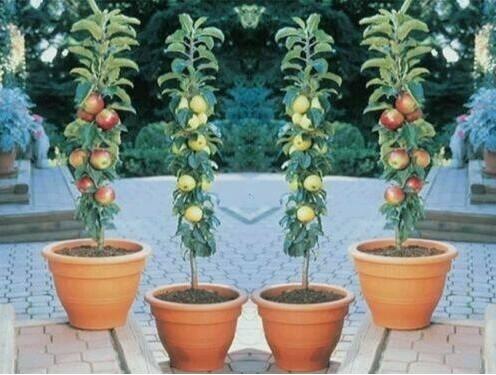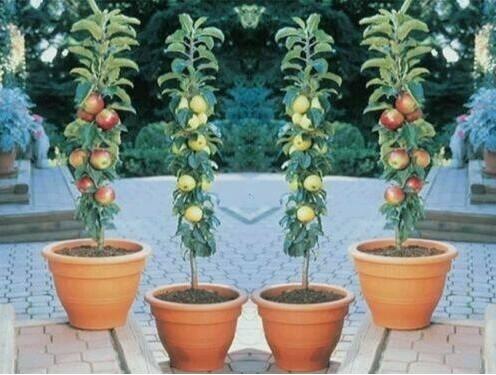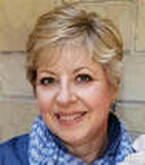|
There is nothing like crisp apples to celebrate fall. Have you ever wanted to try growing your own, but think your yard is too small? Think again! Romantic apple blossoms in spring will enchant homeowners, apartment dwellers, condo owners, suburbanites and those short on space. Columnar (narrow) fruit trees offer structure, fragrant and lovely blooms, fruit, and fall color in a home garden. Popular columnar fruit trees include apples, peaches, plums, and elderberry. When considering your purchase, make sure your fruit tree is not cordoned. Cordoned means it is a full size, regular tree that has been pruned to size. Cordoned trees require skilled and properly timed pruning. The benefits of a small fruit tree are the ease of management and the ability to plant in small spaces. The fruits are easy to pick without having to get a ladder or some other height-stretching tool. Many columnar fruit trees mature at 8 to 10 feet tall, but less than two feet in diameter. An advantage is that many are extremely healthy and disease resistant. When grown in full sun, expect full-sized fruit the first year from planting, so long as they are self pollinating or there are two or more varieties for cross pollination. As trees mature and fertility levels are maintained, the yield of fruit will increase. Design Considerations Columnar fruit trees offer a harvest of tasty fruit within easy reach of the patio table. The impact of a loaded fruit tree in a tiny space is unique, and sometimes irresistible. Columnar trees grown flanking an entrance add a vertical accent to your home. Plant alongside a border or fence to offer screened views. Before purchasing, consider placement and the tree’s design impact as well as the required growing conditions. Provide full sun and make provisions to protect from deer browsing. Other design ideas include:
Spacing for Success: To plant as a hedge, space about 15-20 inches between the trees. With the very slim-growing varieties, Mannequin® and Topmodel, the spacing can also be a little closer together; with the slightly broader varieties, Fresco® and Equilibro®, the spacing can be a bit further apart. Groups of three, in which three columnar apples (different varieties are best) are positioned in a triangle with a spacing of 15-30 inches is an option. Such a planting looks like only one apple column after a few years. Secret to Success: Chill Hours Fruit trees in the stone fruit (peach, apricot and plum) and pome fruit (apple and pear) families require a minimum number of chill hours to set fruit. Chill hours are considered temperatures between 32 and 46 degrees and occur between October and February. Your first step in fruit tree ownership is to determine the amount of chill hours in your area. To do this, contact your local nursery or cooperative extension office or visit Azure to calculate your chill hours. The simplest way to determine chill hours of a tree is to look at the tag on the tree – it will say how many chill hours are required – if it doesn’t and you don’t know – DON”T BUY THE TREE. What Type of Tree? A google search will offer a selection of columnar trees. As mentioned earlier, columnar trees are not the same as cordon fruit trees. Minarette fruit series is an example of a cordon fruit tree. Popular columnar apple varieties include Ballerina and Urban series. The Crimson Rocket is a popular peach variety (no sponsorship). For hedge plants consider the more vigorous Malini® columnar apple varieties, which reach a height of approximately 10 ft after 8 years. Other varieties to consider for hedge plants include: Dulcessa®-Fresco®, Malini-Equilibro®, Cuckoo® and also the latest novelties Malini®-Mannequin and Malini®-Topmodel that ripen in September. Malini®-Subito®, Pronto® and Greenlight® form a significantly more compact hedge (with a height of about 6-8 ft. after 7-8 years). Homeowner Growing and Maintenance Tips: If planting in the ground, conduct a soil test. Tests are available through your co-operative extension office or garden centers like Lowe’s and Home Depot. These are inexpensive and provide a wealth of information, saving you money in the long run . Cooperative tests cost as little as $15 and will explain the type of soil enhancements needed for healthy fruit trees. For new plantings, dig a hole one and a half times wider than the plant's container; place plant in hole, keeping the top of the root ball ground level; and back fill with dirt. Water thoroughly and then mulch around the base to conserve moisture and reduce weeds. New plantings require more frequent watering than established plants. Wind, temperature and soil are factors to consider in watering. Feed plants in early spring and again in early fall with an all-purpose fertilizer, following label instructions. Pruning columnar fruit trees is simple: all side shoots that are more than 8 inches long should be cut back in the spring to 2-6 inches. Period. At most, and especially when the growth is very vigorous, this cut can be done twice a year; once before the beginning of the growing season, at the end of February, and once in the summer around the longest day. There are many varieties of columnar fruit trees to choose from, including peaches and apples. To summarize, narrow fruit trees add a refreshing exclamation point to a home garden, through vertical interest, spring blossoms, edible fruit, and attractive fall color. They will make an “appealing” year-round statement in your landscape.
4 Comments
1/25/2021 01:31:52 pm
It's cool that you elaborate on how having fruit trees can improve the aesthetics of your garden. I want my garden to be an enchanting oasis, so I'm considering buying some fruit trees for it. I'm going to search for a good nursery in my area that can sell me some fruit trees.
Reply
9/13/2021 05:59:03 am
Reply
Your comment will be posted after it is approved.
Leave a Reply. |
Thank you for finding us! Holly and I have collaborated to bring you informative, fun, and seasonal garden inspiration blogs.
Subscribe to receive our blogs on the 1st and 15th of the month--Gwen Follow my landscape & garden design Pinterest Page to see more pics, inspiration and Gwen's home garden journey!
AuthorsGwen Wisniewski: Landscape and Garden Designer. Contact me. Let me help you integrate these garden inspirations. Choose the links below to find out more about my landscape design service or to make an appointment. |


















 RSS Feed
RSS Feed